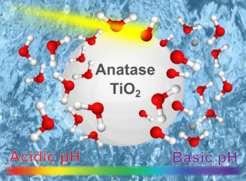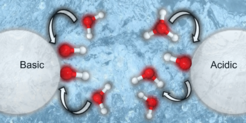Exploration of the Nature of Water Interaction with TiO2 Nanoparticle Surfaces

The nature of water interaction with TiO2nanoparticle surfaces examined as a function of pH using liquid-jet photoelectron spectroscopy
Switching from fossil fuel to clean and renewable energy sources are essential to save our planet from climate change, environmental pollution, and global warming, and to cope with the increasing energy demand arising from the quickly developing industrial society. Conversion of solar energy into H2 fuel is one of the best candidates as a future energy source. Hydrogen fuel production by decomposing water molecules at the TiO2 surface (catalyzing material) under applied bias (photoelectrochemical cell conditions) was reported in the early '70s. Up to now, solar energy conversion into H2 fuel is not efficient enough and competitive enough for a viable industrial application. Many efforts have been made to improve the TiO2-catalyzed energy conversion efficiency in water-splitting reactions. However, the fast back-reaction of a proton (H+) and hydroxide (OH–) recombination into water molecules reduces the efficiency significantly. Hence, it is essential to investigate the electronic structure of the TiO2–water interface. Such information is accessible by photoelectron spectroscopy, an ultra-high vacuum-based technique, which is the method exploited in the present study. In order to make photoelectron spectroscopy applicable to highly volatile water, a micron-sized vacuum liquid jet is generated. Stable liquid jet from TiO2 nanoparticles dispersed in water requires to charge their surface as to avoid aggregation. This has been achieved by the addition of HNO3 and HCl, on the one hand, yielding very acidic pH and by the addition of NH4OH, which leads to slightly basic solutions. A critical aspect then is to keep the surface nanoparticle surface coverage sufficiently low as to provide free adsorption sites for water. Several previous approaches to examine this solid-liquid interfacial layer were limited to model systems in which only a few layers of water – too few to exhibit bulk solution properties – could be stabilized for photoelectron spectroscopy application. This also implies that pH was not an experimental variable. Those approaches had reported that water absorbs dissociatively on TiO2 defect surface sites, and it is either molecularly or partially dissociated on defected free TiO2 surfaces.

pH dependent TiO2– water interaction mechanism
In our study, we had first ruled out any anatase phase transformation or any change in the Ti4+ oxidation state, due to defect surface sites, by recording the Ti L-edge partial electron yield X-ray absorption spectra from all the studied TiO2 nanoparticles aqueous solutions. Also, we explored the non-resonant and the resonant O1s photoelectron spectra as well as the O K-edge partial electron yield X-ray absorption spectra to differentiate the formed molecular species upon water interaction with the TiO2 surface in the different chemical environment (HCl, HNO3 and NH4OH aqueous solution). Our results reported that water adsorbs molecularly at the Ti sites in acidic pH while it is dissociatively interacting with the TiO2 surface in the above neutral condition (pH~7.8). With the help of a previously reported ambient pressure photoelectron study from a similar surface at neutral pH, where mixed (association/dissociation) adsorption at the TiO2 surface was observed, we proposed a TiO2–water interaction mechanism. This mechanism is depending on the surrounding aqueous solution pH. Our results are not only answering a long-standing question about the nature of TiO2—water interaction but also provide a means to control it and enhancing the hydrogen fuel production in photoelectrochemical cells.
This research is part of a larger project on “transition metal oxide nanoparticles – aqueous interfaces”, and has been largely conducted with the PhD research of Hebatallah Ali, embedded within liquid microjet groupat the Fritz Haber Institute headed by Dr. Bernd Winter. This work was conducted in collaboration with Dr. Robert Seidel, heading the operando interfacial photochemistry group, at Helmholtz Zentrum Berlin, during an allocated soft X-ray beamtime at the U49- PGM-1 beamline, Bessy II, Berlin, using the SOL3-PES experimental setup. This project was financially supported by the Egyptian Ministry of Higher Education and Ain Shams University (PhD grant), the Deutsche Forschungsgemeinschaft (DFG) within the Collaborative Research Center 1109 ‘Understanding of metal oxide/water systems at the molecular scale: structural evolution, interfaces, and dissolution’, and an Emmy Noether Young Investigator stipend (DFG project SE 2253/3-1)













